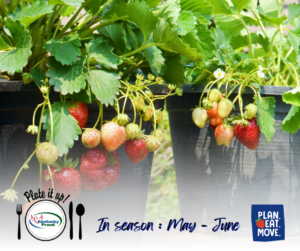
Strawberries are a favorite fruit for many people, and it’s no wonder why! These sweet and juicy berries are the first fruits to ripen in the spring and can be grown in every state in the United States. In fact, they are one of the most popular small fruits to grow in home gardens. Did you know that some varieties of strawberries, when managed well, can produce a good crop as early as mid-summer and last for five to seven years before needing to be replaced?
Not only are strawberries tasty, but they are also packed with nutrition. These berries are low in calories, with just 55 calories in one cup. They are an excellent source of vitamin C, which helps keep our immune system strong. Strawberries also contain vitamin A, iron, fiber, and folic acid. Folic acid is especially important for women who plan on having children, as it has been proven to prevent certain birth defects.
Strawberries have a rich history and have been valued for their medicinal properties. Did you know that ounce for ounce, strawberries have more vitamin C than citrus fruits? Vitamin C is known to lower the risk of certain cancers of the gastrointestinal tract, according to the American Cancer Society.
When selecting strawberries, choose fully ripened berries that are bright red in color. Strawberries do not ripen further after they have been picked. Look for plump berries with a natural shine and bright green caps. It’s best to use strawberries as soon as possible after picking them to enjoy their best flavor and highest nutritional value. Avoid berries with large uncolored or seedy areas, as well as those that appear dull or soft.
Proper storage is essential to keep strawberries fresh. Store them in the refrigerator, unwashed, with the caps on. If you have enough space, you can spread the berries on a cookie sheet and cover them with plastic wrap. Remember to consume the strawberries within one to three days for the best taste and quality.
When it comes to handling strawberries, it’s important to be gentle. Never remove the caps before washing, as they help preserve the flavor and texture of the berries. Wash the berries in gently flowing cool water and let them drain. After washing, remove the caps if necessary and pat the berries dry with paper towels before serving them whole or sliced.
Strawberries are versatile and can be enjoyed in many ways. They make a great snack on their own or can be added to smoothies, and salads, or even used as a topping for pancakes or waffles. You can also freeze strawberries for later use. Simply wash, dry, and hull the berries, then spread them in a single layer on trays in the freezer. Once frozen, transfer them to freezer-safe containers.
Here are some fun facts about strawberries: over half of seven to nine-year-olds consider strawberries their favorite fruit, and eight strawberries provide 140 percent of the recommended daily intake of vitamin C for kids. Native forms of strawberries can adapt to various climates and are found on every major continent except Africa, Australia, and New Zealand. The early strawberries were much smaller compared to the strawberries we enjoy today.
So next time you see these delicious berries, remember to choose the ripest ones, store them properly, handle them gently, and get creative with your serving ideas. Strawberries are not only a tasty treat but also a nutritious addition to your diet. Enjoy the sweet and tangy flavors of strawberries and reap the health benefits they offer!